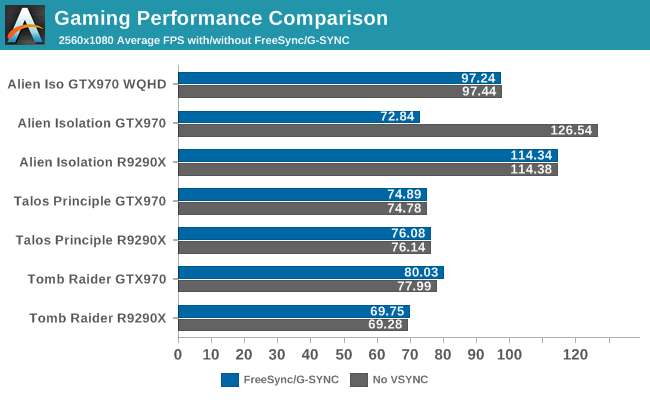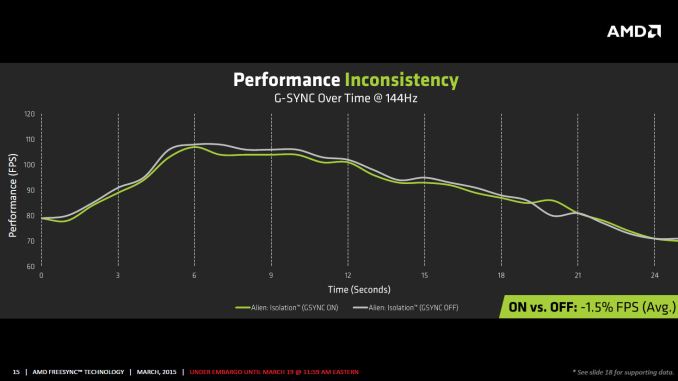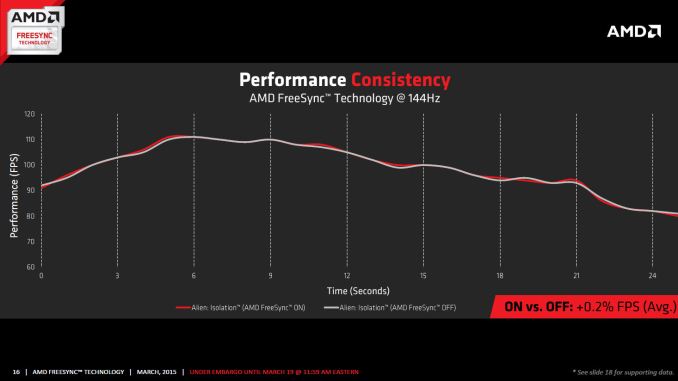The AMD FreeSync Review
by Jarred Walton on March 19, 2015 12:00 PM ESTFreeSync vs. G-SYNC Performance
One item that piqued our interest during AMD’s presentation was a claim that there’s a performance hit with G-SYNC but none with FreeSync. NVIDIA has said as much in the past, though they also noted at the time that they were "working on eliminating the polling entirely" so things may have changed, but even so the difference was generally quite small – less than 3%, or basically not something you would notice without capturing frame rates. AMD did some testing however and presented the following two slides:
It’s probably safe to say that AMD is splitting hairs when they show a 1.5% performance drop in one specific scenario compared to a 0.2% performance gain, but we wanted to see if we could corroborate their findings. Having tested plenty of games, we already know that most games – even those with built-in benchmarks that tend to be very consistent – will have minor differences between benchmark runs. So we picked three games with deterministic benchmarks and ran with and without G-SYNC/FreeSync three times. The games we selected are Alien Isolation, The Talos Principle, and Tomb Raider. Here are the average and minimum frame rates from three runs:


Except for a glitch with testing Alien Isolation using a custom resolution, our results basically don’t show much of a difference between enabling/disabling G-SYNC/FreeSync – and that’s what we want to see. While NVIDIA showed a performance drop with Alien Isolation using G-SYNC, we weren’t able to reproduce that in our testing; in fact, we even showed a measurable 2.5% performance increase with G-SYNC and Tomb Raider. But again let’s be clear: 2.5% is not something you’ll notice in practice. FreeSync meanwhile shows results that are well within the margin of error.
What about that custom resolution problem on G-SYNC? We used the ASUS ROG Swift with the GTX 970, and we thought it might be useful to run the same resolution as the LG 34UM67 (2560x1080). Unfortunately, that didn’t work so well with Alien Isolation – the frame rates plummeted with G-SYNC enabled for some reason. Tomb Raider had a similar issue at first, but when we created additional custom resolutions with multiple refresh rates (60/85/100/120/144 Hz) the problem went away; we couldn't ever get Alien Isolation to run well with G-SYNC using our custome resolution, however. We’ve notified NVIDIA of the glitch, but note that when we tested Alien Isolation at the native WQHD setting the performance was virtually identical so this only seems to affect performance with custom resolutions and it is also game specific.
For those interested in a more detailed graph of the frame rates of the three runs (six total per game and setting, three with and three without G-SYNC/FreeSync), we’ve created a gallery of the frame rates over time. There’s so much overlap that mostly the top line is visible, but that just proves the point: there’s little difference other than the usual minor variations between benchmark runs. And in one of the games, Tomb Raider, even using the same settings shows a fair amount of variation between runs, though the average FPS is pretty consistent.


















350 Comments
View All Comments
marraco - Thursday, March 19, 2015 - link
I ever owned nVidia GPUs (not fue to fanboyism, but the coincidence of geforces being the sweet spot each time I needed a new card).Still, I will not pay for G-SYNC. I don't want to be tied to a company.
I also can't buy a FreeSync, because is not supported by nVidia.
Also, hardware supported features tend to turn obsolete at a faster rate than software ones, so I do not trust G-Sync.
Murloc - Thursday, March 19, 2015 - link
same here, I can just wait a year or so before upgrading monitor and gpu, their loss. If in the meanwhile AMD comes up with something competitive (i.e. also not an oven please), they win.Norseman4 - Friday, March 20, 2015 - link
But you can buy an Adaptive Sync monitor and use it with any GPU. You won't get the benefits of FreeSync without AMD, but that is all.Tikcus9666 - Thursday, March 19, 2015 - link
I aint overly worried, tearing does not bother me, I can't say I really notice it when playing, however I am only playing at 1080p with a Radeon 280steve4king - Thursday, March 19, 2015 - link
Hats off to Nvidia for delivering G-Sync and getting the ball rolling on this thing. They were the first to create a solution for a very real problem.Because of NVidia's pioneering, and because NVidia won't license the technology to AMD, AMD had to find their own solution in re-purposing an existing DP1.2a feature to provide the same function.
It makes sense for NVidia to refuse to support adaptive refresh, until these displays become commonplace. They had the only card and the only display module that could do this, and they needed to sell as many as they could before the competition's technology was viable.
Soon NVidia needs to reverse that decision, because I'm not going to buy an inferior monitor, just so that I can slap "The Way It's Meant to Be Played" on the side of my computer.
I fully expect that both will come together on this one. NVidia had a good run with G-Sync. But now it needs to jump on the bandwagon or risk losing out on GPU sales.
PPalmgren - Friday, March 20, 2015 - link
Unfortunately, I doubt it. While they are great first movers, look at their track record of good tech that could be great tech with industry-wide adoption via less proprietary measures: PhysX, CUDA, 3D Surround, Gsync, etc. They also have a poor history of working with more open platforms like Linux. "Our way or the highway" is the vibe I get.Soulwager - Thursday, March 19, 2015 - link
What about actually testing the fallback cases, where framerate is outside the monitor's range of refresh rates? We need an input lag comparison when both monitors are maxed out in v-sync mode, and a gpu utilization comparison when framerates dip below the monitor's minimum refresh rate.ncsaephanh - Thursday, March 19, 2015 - link
Finally, some competition up in here.czesiu - Thursday, March 19, 2015 - link
"One final topic to address is something that has become more noticeable to me over the past few months. While G-SYNC/FreeSync can make a big difference when frame rates are in the 40~75 FPS range, as you go beyond that point the benefits are a lot less clear. Take the 144Hz ASUS ROG Swift as an example. Even with G-SYNC disabled, the 144Hz refresh rate makes tearing rather difficult to spot, at least in my experience. "Does 144hz monitor help when the FPS is ~40?
JarredWalton - Thursday, March 19, 2015 - link
Sure. It draws the frames 3-4 times between updates, so even if half of the frame showed tearing on the first pass it gets cleaned up on the second and third passes. And with VSYNC enabled, you can fall back to 72Hz and 48Hz before you are at ~30 Hz.